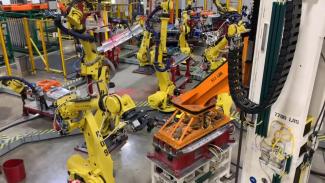A Guide to Monitoring Machine Performance
Machine Monitoring: How to Improve Manufacturing Machine Performance and Uptime
One of the biggest challenges manufacturers face today is ensuring their machines and factory floor processes are working efficiently with maximum uptime. This is where machine and condition monitoring comes into play. Machine and condition monitoring are both used to track the performance and health metrics of machines involved in manufacturing. This helps decision-makers refine their production processes and carry out maintenance work before costly failures occur. In this article, we will dive into how exactly machine and condition monitoring work and what manufacturers stand to gain from implementing this type of technology.
What is Machine Monitoring?
First, we’ll look at machine monitoring. Machine monitoring uses IIoT technology to collect data from all the machines on the factory floor, allowing decision-makers to work towards improving performance and efficiency. Here are a few examples of the data a single machine can collect:
- Machine status: On/off, run rate, speed
- Downtime & utilization: Planned/unplanned stops
- Quality: Right part first time (RPFT), scrap rate
- Operator effectiveness: Labour productivity and efficiency
- Environmental status: Humidity, vibration, temperature
- Energy: Electricity use
This data is collected from machines, transferred to the internet, then monitored and analyzed. It’s fundamentally a simple process.
At Plex, we define machine monitoring as:
The process of extracting, storing, and displaying machine data to enable real-time production monitoring and advanced analysis of performance metrics.
Why is Machine Monitoring Important?
Machine monitoring is important for businesses because it allows them to measure manufacturing equipment efficiency. The data collected using this technology is displayed all in one place and can be used to improve the manufacturing process, which in turn increases revenue and helps businesses gain an advantage in competitive industries. Using machine monitoring solutions, manufacturers can identify:
- Machine Availability. When machines are either down or not running properly as well as the cause of the shutdown.
- Production Flow. The exact position and status of a product throughout the manufacturing process.
- Condition of Assets. The health and performance of factory equipment by tracking parameters like temperature, pressure, noise and vibrations.
- Resource Consumption. The consumption of resources like fuel, electricity, lubricant, and coolant.
- Precise Operations. Tool path, tool lifecycle, feed rate, etc., for increased machine accuracy.
Analyzing data collected on the above reduces machine downtime, improves delivery times, reduces waste, and optimizes program efficiency.
How Machine Monitoring Can Improve Asset Performance
In this section, we’ll look at how machine monitoring improves asset performance and what businesses stand to gain from implementing this type of software. Here’s how a machine monitoring solution can benefit your industry:
Increased Efficiency. The goal for manufacturers is to achieve excellent product delivery at maximum quality. Machine monitoring means more accuracy in identifying faults; this allows for faster repairs and reduces downtime, keeping the production process running smoothly. Performance metrics also provides insight into the working condition of machines. Manufacturers can use this data to identify weak points in the production process and work to improve efficiency and speed.
Waste Reduction. Monitoring the consumption of resources means manufacturers can now maintain a track record on resource wastage. Using this data, they can implement the necessary changes needed for reducing waste. Tracking machine health also contributes to waste reduction by minimizing equipment pollution output.
Improved Communication. Machine monitoring collects data from all machines on the shop floor and displays it in one place. This visualization provides manufacturers with a clear overview of all the different processes, allowing for better collaboration between different plant operators. It also automates tasks like downtime detection and noise identification, freeing the human workforce for more complicated tasks.
Real-Time Notifications. Manufacturers are notified of any faults or small obstacles like downtime by an alert module. Not only does this mean problems can be identified and fixed faster, but it also saves employees time and allows them to take situation-based action to avoid further machine damage.
Getting Started with Machine Monitoring Solutions
If you think your business would benefit from machine monitoring technology, Plex asset performance management (APM) platform offers all the benefits listed above and more. Implementing this software will eliminate downtime and ensure all production targets are hit. It identifies and prevents machine health incidents and manages all your data in one system to create context and connected workflows.
You can make a successful start with machine monitoring solutions by following these six steps to APM success:
- Determine your business goals. Don’t get caught up in the hype of IIoT technology, focus on specific benefits like measuring machine health.
- Define success. Link your goals to specific machine monitoring metrics.
- Create a plan. Create a plan for implementation to reap the benefits of machine monitoring.
- Get organizational buy-in. Engage the right decision makers with the benefits of machine monitoring and secure approval.
- Implement. Transform your factories into connected plants with this technology.
- Rinse and repeat. Think of machine monitoring implementation as part of a company-wide digital transformation, not a one-off project.
Businesses utilizing Plex APM technology can expect a healthier bottom line, consistent deliveries on customer commitments, optimized plant performance and throughput, and minimized risks to reputation. If you’d like more information, you can find capabilities, case studies and a product demo here.



